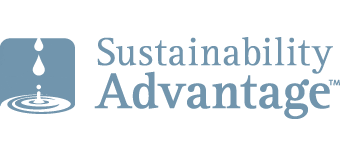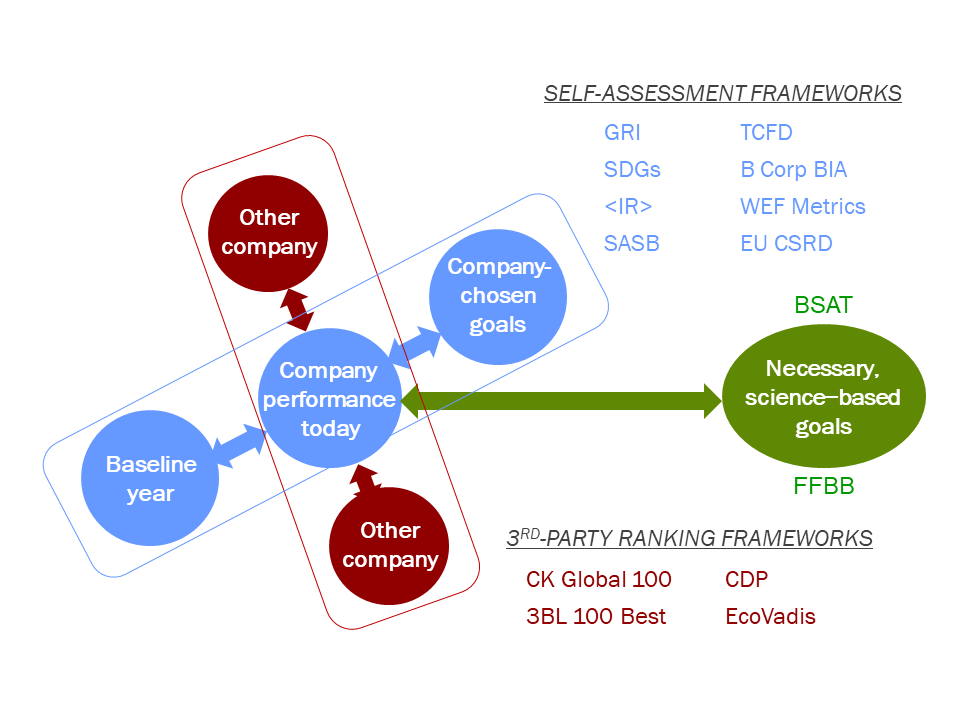OVERVIEW
The above figure shows how some sustainability frameworks are used to plan, assess and report on progress towards goals that organization have set for themselves (e.g., GRI, SDGs, , SASB, TCFD, B Corp BIA, ISO 26000). Some frameworks are used by 3rd parties to rate and rank companies on their sustainability performance (e.g., Global 100, DJSI, 100 Best Corporate Citizens, CDP). The Future-Fit Business Business Benchmark (FFBB) enables companies to do both. It assesses company performance on necessary science-based sustainability goals that best-available science says they must meet if we are to sustain a good quality of life for human civilization on our finite planet.
Why bother doing an assessment?
The results of the comprehensive sustainability assessment can be used to serve the information needs of diverse stakeholders.
- Senior management: By integrating sustainability / ESG performance data into internal management information systems and governance practices, executives and boards can ensure that they are capturing opportunities and avoiding risks on priority sustainability-related issues. As a minimum, they can fulfill their duty of care and ensure the organization obtains full eco-efficiency savings and reputational value from its sustainability efforts.
- Employees: Employees are more engaged and productive when they learn that their organization is a force for good on issues that they care about. Engaging employees from various departments in completing an assessment can be a collaborative, team-building exercise that builds employee pride and loyalty.
- Customers / buyers: Public and private sector institutions are increasingly using sustainable procurement to purchase the most sustainable goods and services from the most sustainable suppliers – those doing the least harm and the most good. Suppliers disclosing their sustainability scores earn more points on the buyer’s weighted sustainable-supplier criteria.
- Investors / lenders / insurers: An organization’s disclosure of its social and environmental performance, and its preparedness for social and environmental crises like pandemics and climate change, helps providers of capital and insurers assess the organization’s eligibility for preferential treatment as a low-risk investee, borrower, or insuree.
- Governments: In some jurisdictions (e.g. the European Union), governments are now asking companies to report on their sustainability performance.
- Foundations: Foundations support organizations that are being proactive on environmental and societal issues that align with the foundation’s mission. A self-assessment provides foundations with better information on the organization’s environmental, employee and community impacts that it may want to amplify.
- Raters / Rankers: Increasingly, an organization’s sustainability performance is considered when ranking organizations in all sectors. Results from a comprehensive sustainability assessment help avoid survey fatigue.
The free, open-source tools below help satisfy these stakeholder needs. They score progress toward causing no harm to people and planet, and give credit for the organization’s positive impacts.
Comparison of Sustainability Assessment Frameworks
This free, open-source spreadsheet / table compares how the dozen sustainability reporting, assessment and ranking frameworks in the above figure address the same 18 core environmental, employee, community and governance sustainability topics / issues.
Slides about sustainability assessment frameworks
Master – Sustainability Frameworks: This is one of six Master Slide Decks available to subscribers. It contains an overview of: sustainability reporting status; sustainability frameworks including overview slides for the Basic Sustainability Assessment Tool (BSAT), the Advanced Sustainability Assessment Tool (ASAT), and the Net-Zero Assessment Tool; sustainability ranking frameworks; and business model frameworks. The deck is updated quarterly.


